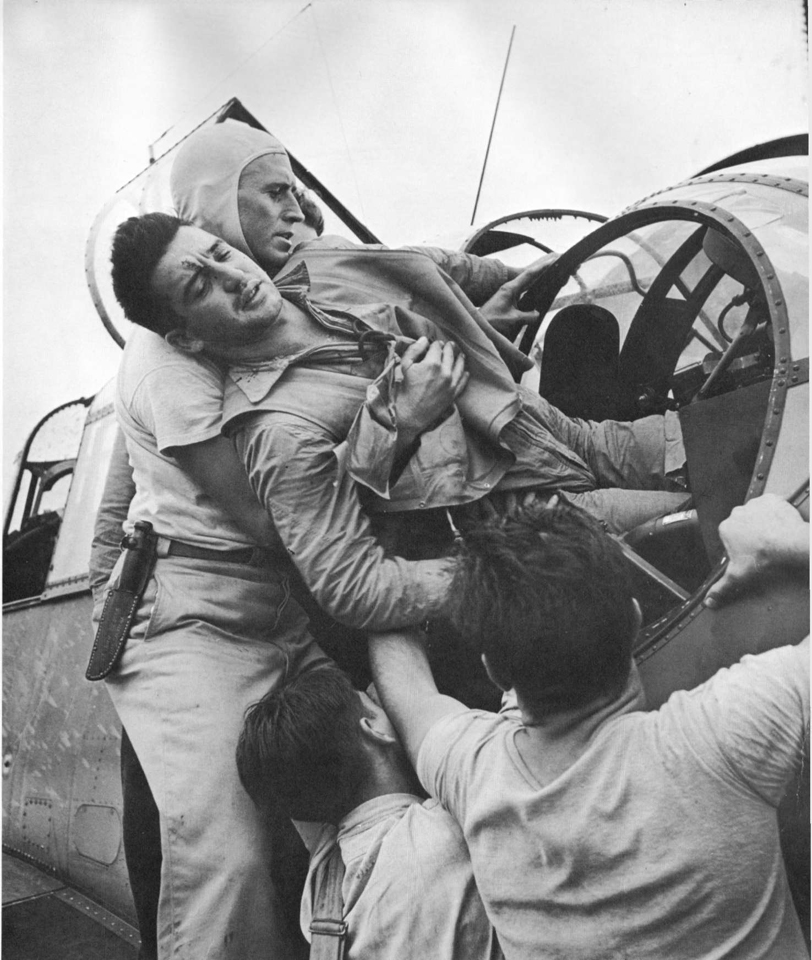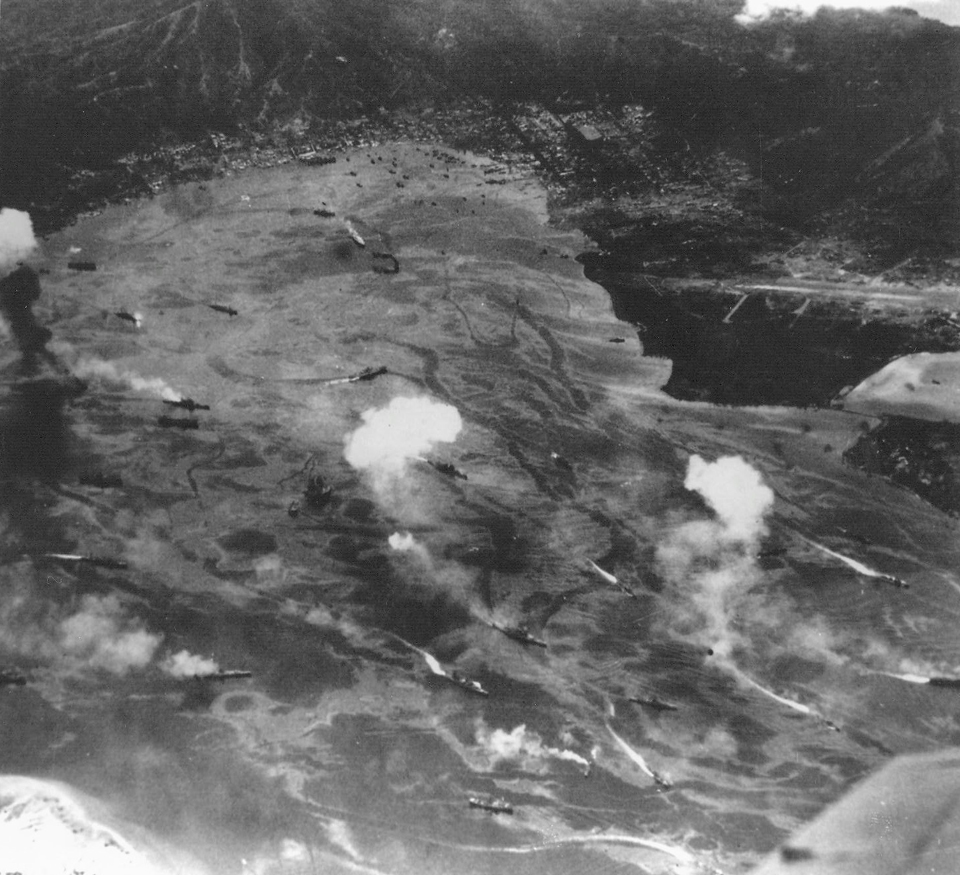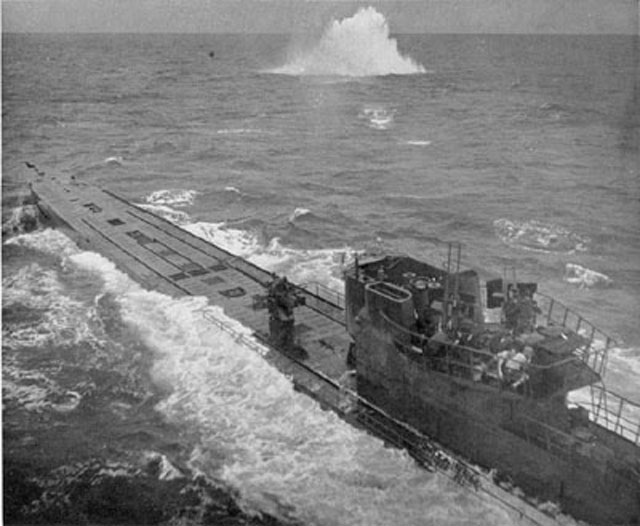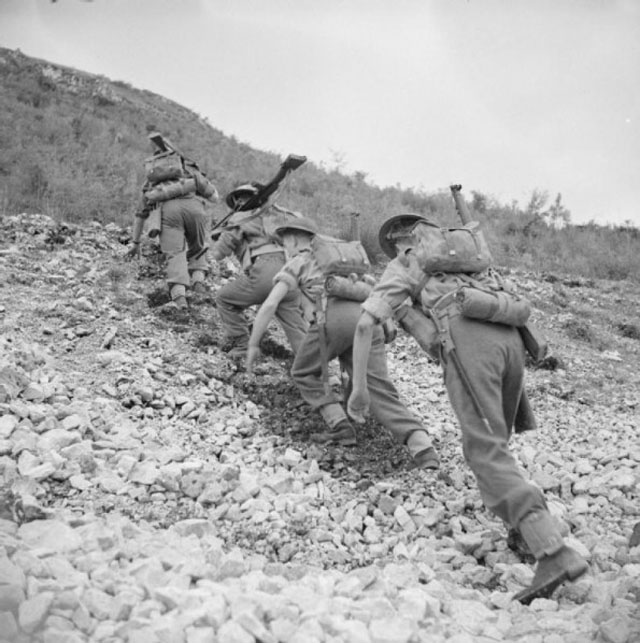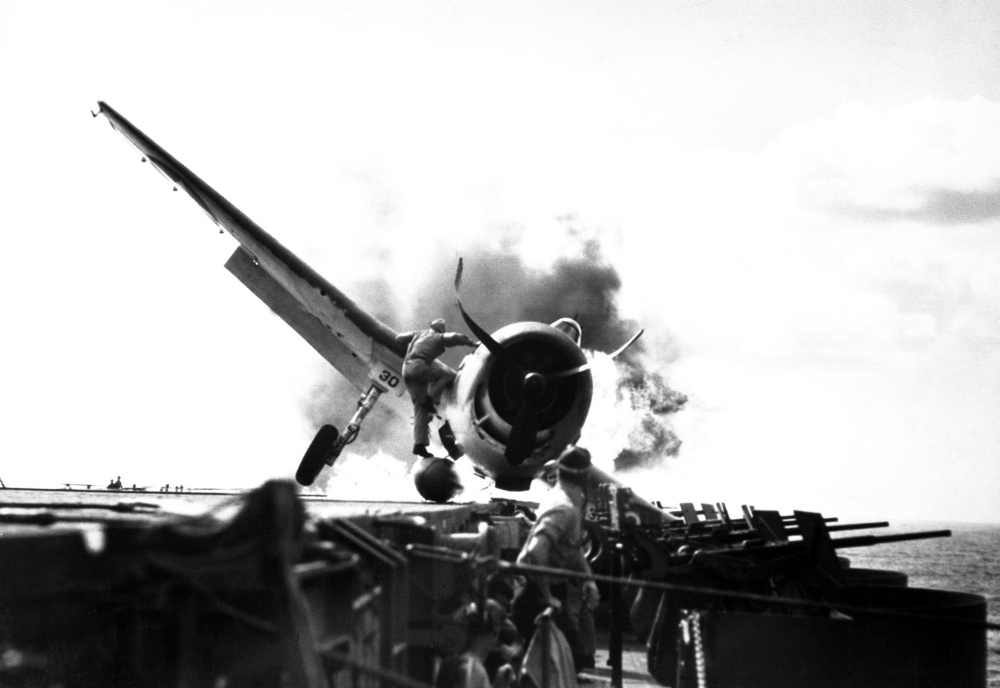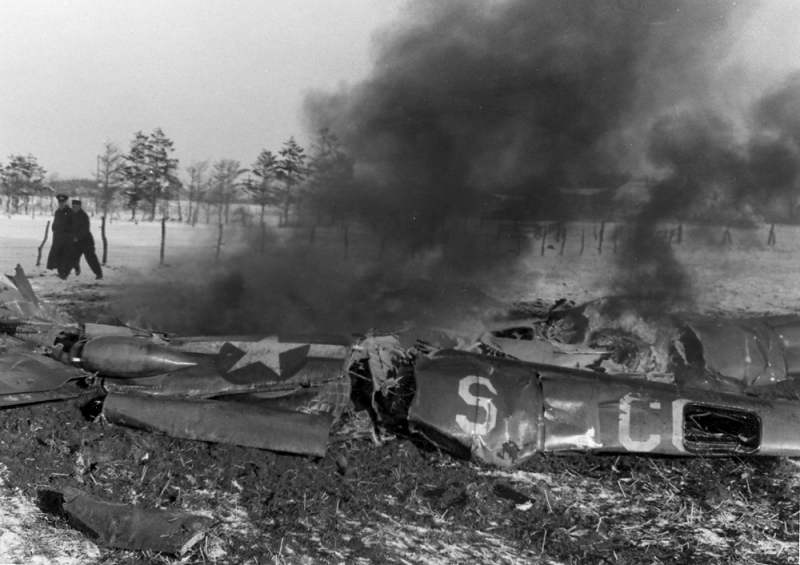Air Operations, Bismarcks
- Starting at 1010 hours, while US Navy F6Fs based at the Barakoma airfield at Vella Lavella cover the carriers, 22 SBDs, 23 TBFs, and 52 F6Fs from Task Force 38 attack ships and facilities in Rabaul harbor. At a cost of 1 SBD, 4 TBFs, and 5 F6Fs lost (mostly to antiaircraft fire), 4 Japanese heavy cruisers, 2 light cruisers, and 2 destroyers are severely damaged (mainly by the SBDs). US Navy F6Fs (and several SBD and TBF crews) down 1 Ki-21 'Sally' bomber and 27 A6M Zeros and Ki-61 'Tonys;. 5 F6Fs and 5 US carriers bombers are lost with 7 pilots and 8 aircrewmen. As a result of this attack, all Japanese surface warships at Rabaul are ordered to Truk Atoll, thus ending the threat of a surface attack against the Bougainville invasion fleet. Upon completion of the day’s strike against Rabaul, Task Force 38 withdraws from range of Japanese land-based aircraft.
- As Japanese aircraft based at Rabaul search in vain for the US carriers, 90 V Bomber Command B-17s and B-24s escorted by 67 V Fighter Command P-38s pass up the deserted airfields in the Rabaul area and attack the Rabaul wharf area instead.
- 1 49th Fighter Group P-38 downs 2 A6M Zeros over Rabaul at 1215 hours.
Air Operations, Central Pacific
VD-3 PB4Ys mount their first mission to the Marshall Islands, where they photograph defenses and facilities in Mille Atoll.
[Air Operations, Europe
The Vatican is bombed by Allied aircraft.
RAF BOMBER COMMANDEvening Ops:
- 26 Mosquitos make small attacks on Bochum, Dortmung, Düsseldorf, Hamburg and Hannover. 27 OTU Wellingtons make leaflet flights over France.
- There are no losses.
GERMANY:
- 323 1st and 3rd Bomb Division B-17s and 5 B-17 pathfinders attack the oil refinery and marshalling yard at Gelsenkirchen with 739 tons of bombs between 1313 and 1350 hours.
- 8 B-17s are lost to flak and Luftwaffe fighters, 219 damaged; 4 crewmen killed, 31 wounded, 84 missing
- 104 2nd Bomb Division B-24s plus 4 B-17 pathfinders attack a marshalling yard at Munster with 284 tons of bombs between 1349 and 1358 hours.
- 3 B-24s are lost, 44 damaged; 7 crewmen killed, 22 wounded, 31 missing
- Escort and support for the heavy bombers is provided by 336 P-47s and 47 P-38s, which down 19 Luftwaffe fighters, mostly over the Netherlands between 1300 and 1430 hours.
- 4 P-47s and their pilots are lost
FRANCE:
- Despite numerous aborts due to bad weather, more than 150 IX Bomber Command B-26s attack a secret military construction site at Mimoyecques.
- 1 B-26 is lost
ALBANIA:
- XII Air Support Command B-25s attack the Berat/Kocove Airdrome.
- NATAF aircraft attack roads and bridges in or near Atina, Cassino, Castrocielo, Isernia, Lucana, Rome, Pescara, and Vasto.
- NATAF aircraft attack ships off Split.
Air Operations, New Guinea
- 22nd Medium Bomb Group B-25s and B-26s attack Japanese Army infantry positions near Bogadjim with 23 tons of bombs dropped from very low altitude. V Bomber Command B-25s attack ground positions near Dumpu. V Fighter Command P-39 fighter-bombers attack Madang.
- 348th Fighter Group P-47s down 5 Ki-61 'Tony' fighters and 1 A6M Zero near Wewak at 1105 hours.
Air Operations, Pacific
Corsairs from Totokina airstrip, Bougainville, escort USAAF bombers to Rabaul.
[Air Operations, Solomons
- 6 42nd Medium Bomb Group B-25s on a sweep around Bougainville attack a bivouac at Kieta and sundry barges.
- Following the supposed sighting of Task Force 38 at 1445 hours by Rabaul-based search aircraft, 18 Rabaul-based B5N 'Kate' bombers attack a tiny convoy composed of 1 US Navy landing-craft gunboat, 1 PT-boat, and 1 landing craft. The PT-boat is damaged when a 'Kate' crashes into it, and the gunboat is damaged by a torpedo that does not explode. Despite this, the returning Japanese pilots report the sinking of 2 carriers, 3 cruisers, and 1 destroyer. 1 'Kate' crashes into the PT-boat and another is downed by ships’ fire.
Battle of the Atlantic
- Capt Frederick J. Walker's 2nd Support Group saves Convoy HX-264 and sinks 2 U-boats.
- The German submarine U-848 is sunk by US Naval land-based aircraft (VB-107) and Army aircraft in the South Atlantic area.
| Class | Type IXD2C |
| CO | Korvettenkapitän Wilhelm Rollmann |
| Location | Atlantic, SW of Ascension Island |
| Cause | Air attack |
| Casualties | 63 |
| Survivors | None |
Eastern Front
The Soviet threat to encircle Kiev grows as they cut the Kiev-Zhitomir railroad and continue to advance at practically pursuit pace. In the south they completely overrun the area between the lower Dniepr and the Crimea.
The Russians secretly begin to re-deploy their 2nd Assault Army from Leningrad to the nearby Oranienburg Salient. Numerous small craft of the Baltic Fleet transport 44,000 men, 600 guns and 200 tanks over the next 2 months.
SOUTHERN SECTORThe 38th Army enters Kiev while the 3rd Guards Tank reache Svyatschina. Fighting inside the city is fierce as the VII Corps attempts to escape from the rapidly advancing Soviet armies. Bitter street battles rage through the night. By the end of the day the main railway station and the greater part of the city are in Soviet hands and the 88th Infantry Division has been all but destroyed.
With the battle of Kiev in progress, the 60th Army swings southwest and drives into the rear of the 4th Panzer, pushing along the edge of the Pripet Marshes. The attack throws the LIX Corps and XIII Corps back toward Korosten and Zhitomir.
[France, Resistance
In the first 'Blackmail' operation resistance workers set bombs in the Peugeot factory at Sochaux, destroying equipment used in the manufacture of tank turrets. When the Germans try to bring in new machinery that too is sabotaged. This factory is described by the British Ministry of Economic Warfare as the third most important target in France.
[Italy
The US 5th Army begins major attacks against the 'Reinhard' line, the last bastion before the Germans' final defensive line, the 'Gustav' line. The most important efforts are in the center where the British 56th Division, X Corps, assaults Monte Camino while the US 3rd Division, VI Corps, attacks near the Mignano Gap. The tenacious defense made by Gen Hans Hube's XIV Pzr Corps is aided by the extremely difficult terrain and the vile weather. The attacks make little progress but are continued.
In the 8th Army sector, the V Corps pursues the enemy northward the 78th Division takes Vatto, while the Indian 8th Division takes Tufillo.
[New Britain
Adm Frederick C. Sherman leads Saratoga (CV-3) and Princeton (CVL-23) to attack Adm Takeo Kurita's squadron, newly arrived in Rabaul. 4 heavy cruisers and 2 light cruisers as well as 2 destroyers from the squadron are damaged by the 107 attacking planes. The Americans only lose 10 planes. A second assault, this time by land-based Liberators, adds to the confusion. Serious damage is done to 7 of Kurita's cruisers, the Atago, Maya, Takao, Mogami, Chikuma, Agano and Noshiro as well as to 2 destroyers. The only heavy cruiser undamaged is the Suzuya, which nurses the damaged ships back to Truk. The heavy cruiser Maya and the light cruiser Agano have been too badly hit to try to save them. It is a major disaster for the Japanese whose whole squadron has been wiped out without firing a shot. The threat that it might have posed for the American beachhead on Bougainville has vanished.
[Solomons
BOUGAINVILLEIn the zone of the 9th Marines, the 3rd Ranger Battalion fights off a counterattack by the Japanese 23rd Regiment on a local trail called Mission Trail. Later the Rangers and the 3rd Battalion of the 9th Marines drive up Mission Trail toward its junction with the Numa Numa Trail. These 2 tracks are the main lines of communication in the area of Cape Torokina. Few of the Japanese garrison of the island are being sent to oppose the landings, partly because of the difficult terrain that intervenes between the landing and the main Japanese concentrations but more because the Japanese commander judges that the attack is a feint.
[Scenes from November 5, 1943
|
|
|
|
|
|
